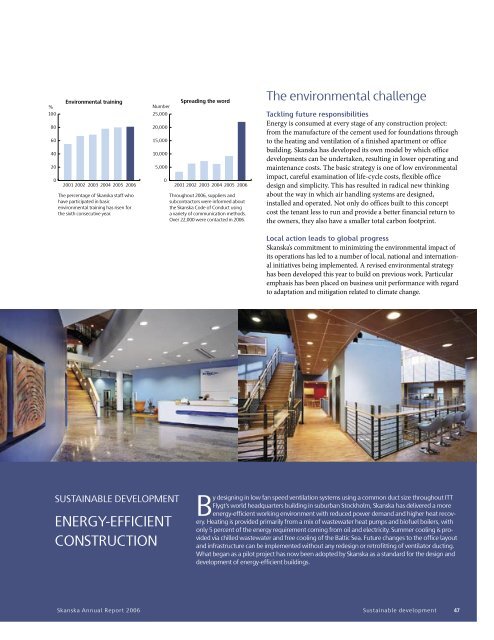ANNUAL REPORT 2006 - Skanska
ANNUAL REPORT 2006 - Skanska
ANNUAL REPORT 2006 - Skanska
Create successful ePaper yourself
Turn your PDF publications into a flip-book with our unique Google optimized e-Paper software.
% Number<br />
100<br />
80<br />
60<br />
40<br />
20<br />
0<br />
Environmental training<br />
2001 2002 2003 2004 2005 <strong>2006</strong><br />
The percentage of <strong>Skanska</strong> staff who<br />
have participated in basic<br />
environmental training has risen for<br />
the sixth consecutive year.<br />
25,000<br />
20,000<br />
15,000<br />
10,000<br />
5,000<br />
0<br />
Spreading the word<br />
2001 2002 2003 2004 2005 <strong>2006</strong><br />
Throughout <strong>2006</strong>, suppliers and<br />
subcontractors were informed about<br />
the <strong>Skanska</strong> Code of Conduct using<br />
a variety of communication methods.<br />
Over 22,000 were contacted in <strong>2006</strong>.<br />
The environmental challenge<br />
Tackling future responsibilities<br />
Energy is consumed at every stage of any construction project:<br />
from the manufacture of the cement used for foundations through<br />
to the heating and ventilation of a finished apartment or office<br />
building. <strong>Skanska</strong> has developed its own model by which office<br />
developments can be undertaken, resulting in lower operating and<br />
maintenance costs. The basic strategy is one of low environmental<br />
impact, careful examination of life-cycle costs, flexible office<br />
design and simplicity. This has resulted in radical new thinking<br />
about the way in which air handling systems are designed,<br />
installed and operated. Not only do offices built to this concept<br />
cost the tenant less to run and provide a better financial return to<br />
the owners, they also have a smaller total carbon footprint.<br />
Local action leads to global progress<br />
<strong>Skanska</strong>’s commitment to minimizing the environmental impact of<br />
its operations has led to a number of local, national and international<br />
initiatives being implemented. A revised environmental strategy<br />
has been developed this year to build on previous work. Particular<br />
emphasis has been placed on business unit performance with regard<br />
to adaptation and mitigation related to climate change.<br />
Number<br />
15,000<br />
Evaluation of chemical products<br />
USD M<br />
10,000<br />
8,000<br />
Projects where environmental<br />
performance exceed regulations<br />
12,000<br />
9,000<br />
6,000<br />
3,000<br />
6,000<br />
4,000<br />
2,000<br />
0<br />
150<br />
120<br />
2001 2002 2003 2004 2005 <strong>2006</strong><br />
The total value of orders, greater than<br />
USD 1 million, incorporating<br />
environmental considerations beyond<br />
legal and regulatory requirements, has<br />
grown again in <strong>2006</strong>.<br />
SUSTAINABLE DEVELOPMENT<br />
ENERGY-EFFICIENT<br />
CONSTRUCTION<br />
Number<br />
Eco design projects<br />
Number<br />
50<br />
40<br />
Eco design professionals<br />
0<br />
2001 2002 2003 2004 2005 <strong>2006</strong><br />
Assessing the environmental impact of<br />
chemicals used in construction is an<br />
important aspect of health and safety<br />
activities within all <strong>Skanska</strong> business<br />
units. Since 2001, over 13,000<br />
different products have been<br />
evaluated.<br />
By designing in low fan speed ventilation systems using a common duct size throughout ITT<br />
Flygt’s world headquarters building in suburban Stockholm, <strong>Skanska</strong> has delivered a more<br />
energy-efficient working environment with reduced power demand and higher heat recovery.<br />
Heating is provided primarily from a mix of wastewater heat pumps and biofuel boilers, with<br />
only 5 percent of the energy requirement coming from oil and electricity. Summer cooling is provided<br />
via chilled wastewater and free cooling of the Baltic Sea. Future changes to the office layout<br />
and infrastructure can be implemented without any redesign or retrofitting of ventilator ducting.<br />
What began as a pilot project has now been adopted by <strong>Skanska</strong> as a standard for the design and<br />
development of energy-efficient buildings.<br />
90<br />
60<br />
30<br />
20<br />
30<br />
0<br />
<strong>Skanska</strong> Annual Report <strong>2006</strong> 47<br />
2003 2004 2005 <strong>2006</strong><br />
A wide range of Eco Design tools are<br />
available throughout <strong>Skanska</strong>’s<br />
10<br />
<strong>Skanska</strong> Annual Report <strong>2006</strong> Sustainable development 47<br />
-0<br />
2004 2005 <strong>2006</strong><br />
The number of trained or accredited<br />
professionals available within <strong>Skanska</strong>

















